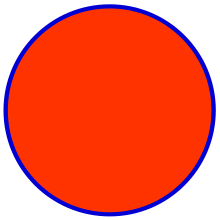Open set
In set theory an open set is a set where all elements have the same properties. Simply put, an open set is a set that does not include its edges or endpoints. For each point in the set, you can make a bubble around that point, such that all points in the bubble are also in the set.[1]

On the other hand, a closed set includes all its edges or endpoints. A set that includes some of its edges or endpoints is neither open nor closed.[2]
An open set is very similar to an open interval.
Examples change
The set (0,1) is open. If we choose a very small value, there will always be a small bubble which are all in the set (0,1).
If we choose a very small value h ∈ (0,1), we can make a bubble , in which all the values are in (0,1).
However, [0,1] is closed. If we choose the value 0, and choose a very small value k, 0-k ∉ [0,1], which means that it's closed.
References change
- ↑ "Open Set". Wolfram MathWorld.
- ↑ "Closed Set". Wolfram MathWorld.